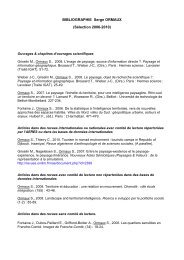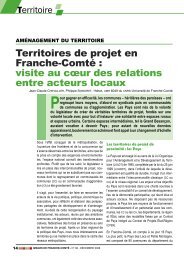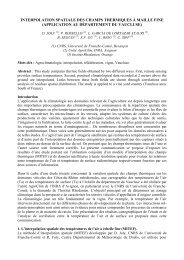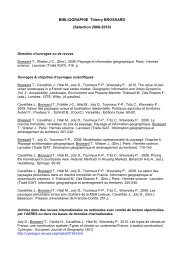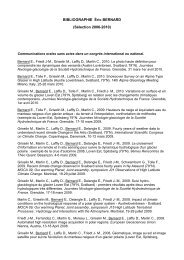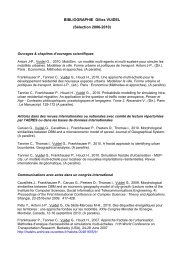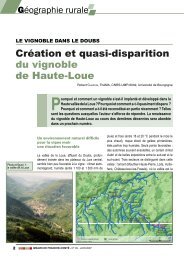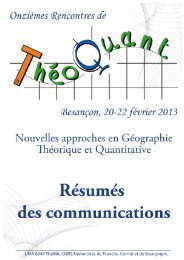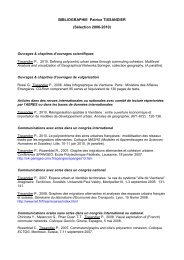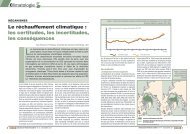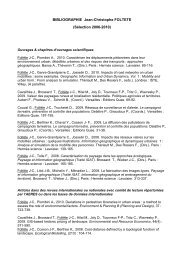Télécharger les résumés - ThéMA - Université de Franche-Comté
Télécharger les résumés - ThéMA - Université de Franche-Comté
Télécharger les résumés - ThéMA - Université de Franche-Comté
You also want an ePaper? Increase the reach of your titles
YUMPU automatically turns print PDFs into web optimized ePapers that Google loves.
SPATIAL ANALYSIS OF THE RETAIL CENTERS<br />
IN THE TEL AVIV METROPOLIS<br />
Lucien BENGUIGUI : Solid State Institute and Department of Physics, Technion - Israel Institute of Technology<br />
ssgil<strong>les</strong>@techunix.technion.ac.il<br />
D. CZAMANSKI : The Klutznick Center For Urban and Regional Research, Technion - Israel Institute of<br />
Technology<br />
ardaniel@tx.technion.ac.il<br />
M. MARINOV : The Klutznick Center For Urban and Regional Research, Technion - Israel Institute of<br />
Technology<br />
marinov@physics.technion.ac.il<br />
RESUME. Complex and dynamic behavior of urban systems has been recognized for <strong>de</strong>ca<strong>de</strong>s. Many of the latest efforts were<br />
aimed at learning about complexity and the manifestations of or<strong>de</strong>r or organization. The limited un<strong>de</strong>rstanding of<br />
regularities observed in urban systems and the inability to predict <strong>de</strong>velopment trends and abrupt changes urged researchers<br />
to seek new approaches and methods of analysis. Some of the approaches originating in natural sciences were applied in this<br />
work.<br />
In this study we focus on the evolution of the Israeli retail within the Tel Aviv metropolitan area, while incorporating new<br />
methods of <strong>de</strong>tecting, quantifying and explaining presence (or lack) of or<strong>de</strong>r in this complex system. The distribution of retail<br />
facilities in the Tel Aviv metropolitan area was analysed in terms of their sizes and spatial structure over a period of 15<br />
years. Surprisingly, the empirical findings did not reveal any evi<strong>de</strong>nce of the expected regularities dictated by the classical<br />
theories of retail structure, such as central place theory or Zipf's law. In search of organization or or<strong>de</strong>r, different methods<br />
are applied in parallel, each enhancing a different range of sizes as measured by Gross Leasable Area (GLA). The<br />
distribution of sizes is well <strong>de</strong>scribed by an exponential function, which holds across time and scale. Consequently, a<br />
hierarchical structure or even a presence of clear-cut size groups is not <strong>de</strong>tected. However, the consistent exponential<br />
distribution may be interpreted as a type of organization, which also displays self-similarity. These observed characteristics<br />
may be associated with the rapidly <strong>de</strong>veloping new types of mo<strong>de</strong>rn retailers in a competitive market suffering from lack of<br />
open spaces available for <strong>de</strong>velopment.<br />
Spatial distribution of retailers proved to be much more challenging, as it did not reveal any clear type of regularity. The<br />
distribution of mo<strong>de</strong>rn retailers was analysed by a combination of methods, some conventional and others - newly<br />
introduced. However, the retail facilities appear to be located more or <strong>les</strong>s randomly within the metropolitan area, with a<br />
slight ten<strong>de</strong>ncy to form clusters, which weakens in the later years. The retail locations do not display a clear affinity to the<br />
spatial distribution of built area or population <strong>de</strong>nsities, although a certain <strong>de</strong>gree of correlation is observed and the<br />
presence of clusters may be attributed to the influence of these factors. Differentiation by type of location reveals that in<br />
more recent years the more intensive growth is occurring in locations on the edge of the built up metropolitan area, rather<br />
than in the center. The lack of spatial hierarchy may again be attributed to the increasing pressure to <strong>de</strong>velop the quickly<br />
disappearing open spaces and the lack of long-term strategic planning for the retailing sector in Israel.<br />
7 èmes Rencontres <strong>de</strong> Théo Quant, janvier 2005



